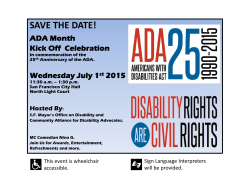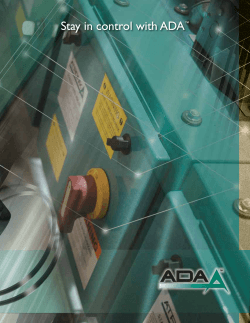
Transitioning from High School to College for
Transitioning from High School to College for Students with Disabilities There are many differences between high school and college. In college, the student is responsible for their own selfmanagement and advocacy. Additionally, the laws that affect students with disabilities are different. Below is a chart that highlights the differences in services for students with disabilities between high school and college. Secondary Education (High School) Postsecondary Education (College) What is the law? Section 504 of the Rehabilitation Act of 1973, particular references in Subpart E (504) Section 504 of the Rehabilitation Act of 1973 (504) Americans with Disabilities Act of 1992 (ADA) Americans with Disabilities Act of 1992 (ADA) What is the intent of the law? IDEA: To provide a free, appropriate, public education in 504/ADA: To ensure that no otherwise qualified person the least restrictive environment to eligible students with with a disability will be denied access to, or the benefits of, disabilities, including special education and relative or be subjected to discrimination by any program or services. activity provided by any public institution or entity. 504/ADA: To ensure that no otherwise qualified person with a disability will be denied access to, or the benefits of, or be subjected to discrimination by any program or activity provided by any public institution or entity. Who is covered under the law? All infants, children and youth requiring special education All qualified persons with disabilities who meet the entry services, until age 21 or graduation from high school. criteria of the college or program and who can document the existence of a disability as defined by the ADA. What is a disability? A list of disabilities is provided in IDEA, and includes Any physical or mental impairment that substantially limits specific learning disabilities. 504/ADA has no such list, but one or more major life activities, having a record of such considers a disability to be any physical or mental an impairment, or being regarded as having an impairment impairment that substantially limits one or more major life (504/ADA); ADA also includes HIV status and contagious activities, has a record of such impairment, or is regarded and non-contagious diseases. as having an impairment. Who is responsible for identifying and documenting need? School districts are responsible for identifying, evaluating, Students are responsible for self-identification and for and planning educational services at no expense to parent obtaining disability documentation from a professional or individual. who is qualified to assess their particular disability; the student, not the institution, must assume the cost of evaluation. Who is responsible for enforcing the law? IDEA is basically a funding statute, enforced by the Office ADA/504 are civil rights statutes, enforced by the Office for of Special Education and Rehabilitation Services in the U.S. Civil Rights (OCR), U.S. Department of Justice, and the Department of Education. Equal Employment Opportunity Commission (EEOC). ADA/504 are civil rights statutes, enforced by the Office for Civil Rights (OCR), U.S. Department of Justice, and the Equal Employment Opportunity Commission (EEOC). Who is responsible for initiating service delivery? School districts are responsible for identifying students Students are responsible for notifying Access Center staff with disabilities and providing special instruction, of their disability and of their need for accommodations. individualized educational plans, and/or accommodations. Accommodations are provided on a per semester basis in order to ensure that the institution’s programs and activities are accessible to all students. Individuals with Disabilities Education Act (IDEA) WSU Access Center; 509-335-3417, access.center@wsu.edu
© Copyright 2025





















